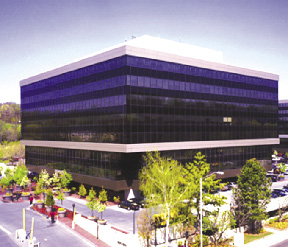Albert Phelps, managing and leasing agent for Merritt 7 Corporate Park has earned the U.S. Environmental Protection Agency's (EPA) Energy Star award, the national symbol for protecting the environment through superior energy performance.
Merritt 7 is the only office park in the state of Conn. to have earned the Energy Star label for energy efficiency and environmental performance.
Merritt 7 received Energy Star recognition for Buildings 201, 301 and 401, three of six buildings that make up the 1.4 million s/f office complex. By earning the Energy Star, Merritt 7 is using approximately 35% less energy than average buildings, while still providing quality service and comfort to its tenants.
"We are pleased to accept EPA's Energy Star in recognition of the energy efficiency efforts put forth at Merritt 7," said John Crosby, chairman and chief executive officer of Albert Phelps, Inc. "Through this achievement, we have demonstrated our commitment to environmental stewardship while also lowering our energy costs." Â
According to the EPA, commercial buildings account for almost 18% of the nation's greenhouse gas emissions. Building owners earn the Energy Star scoring in the top 25% on EPA's energy performance rating system, which calculates scores based on actual energy use. Buildings that earn the Energy Star are the top performers for energy efficiency nationwide, using about 35% less energy than average buildings.
Through a collaborative effort between Albert Phelps, and ING Clarion, the property owner/asset manager, numerous actions were taken over a several year period to make the buildings more energy efficient.
Under the direction of Alan Rich, Merritt 7 facilities manager, building upgrades and property equipment maintenance was completed. This included replacement of HVAC fans, water pumps, garage and common area lighting and lighting fixtures with new tenant installations, as well as generator and elevator mechanical equipment upgrades and replacement of cooling towers in Buildings 101, 201 and 301.
"This is a tremendous accomplishment, and I'm very proud to support Merritt 7 in its efforts," said senator Bob Duff, who serves as vice chair of the Conn. general assembly's energy and technology committee. "This is a great example of how energy efficiency can be integrated into a commercial building with exceptional results. This is the new generation of office space, and hopefully Merritt 7 can serve as a shining example of how green technology can work hand-in-hand with commercial enterprises for other organizations across Conn. Congratulations to all who made this possible."
In addition, Merritt 7 participated in the demand response program with CL&P, part of an effort to avoid summer brown outs. It requires each building to shed 100 kilowatts of electricity within 30 minutes notice and in exchange, CL&P provides Merritt 7 with credit based on the decrease in kilowatt hours.
Merritt 7 also installed CL&P data recording/metering devices to enable the landlord to monitor electrical consumption and provides control of unusual conditions or spikes in electrical usage. The property is also part of the CL&P RCX Project, another energy saving measure which involves further analysis of the energy requirements of the park.
 "The desire for environmentally friendly buildings is expanding rapidly and energy efficiency is a critical element of green buildings," said Margaret Egan, vice president of ING Clarion. "We are proud to be a part of this new generation of office buildings that make sense for our environment and the bottom line. The Energy Star label is a great way for Merritt 7 to be recognized and awarded for our proactive energy efficiency efforts."
Energy Star was introduced by EPA in 1992 as a voluntary, market-based partnership to reduce greenhouse gas emissions through energy efficiency. Products and buildings that have earned the Energy Star designation prevent greenhouse gas emissions by meeting strict energy-efficiency specifications set by the government.
 (1).png)









